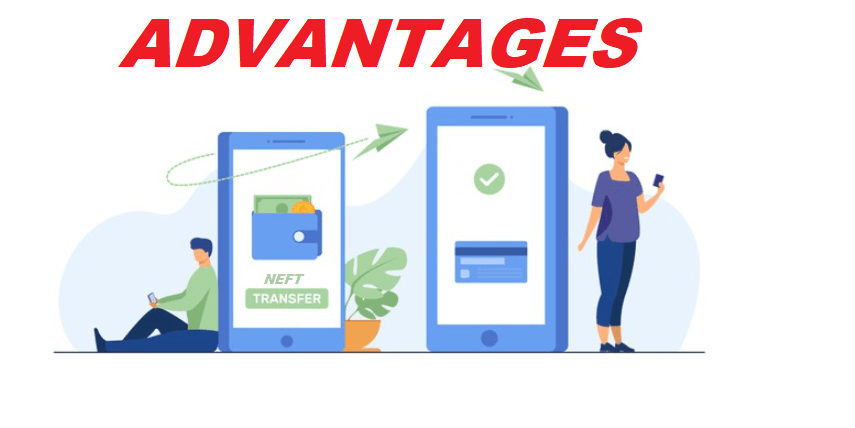Full form of NEFT
Full form of NEFT: A majority of Indian population encounters the term NEFT while initiating payments through online banking services. Yet, most of them are still not aware of its full form.
The full form of the famous banking abbreviation NEFT is National Electronic Funds Transfer.

This tutorial will briefly cover the definitions, special points, fundamentals, Steps to follow to transfer money through NEFT, advantages of NEFT System, chances of failure and other detailed information related to NEFT or National Electronic Funds Transfer.
What is NEFT?
“NEFT or National Electronic Funds Transfer is a nation-wide electronic transfer system of funds from one Indian bank account to another bank account. This electronic transfer system operates on DNS (Deferred Net Settlement), processing the batches' transactions instead of constant individual settlement unlike RTGS.”
NEFT is one of the processes through which an individual can transfer money through his bank account to another person's account within India. NEFT empowers any person, organization, firm, and corporates to send funds electronically to another individual pursuing a bank account in the nation. NEFT payments are processed in batches instead of other methods that process the transactions on an orderly basis. As requests get queued up, the sets are processed hourly to clear off the pending transactions. To remit money through NEFT, the only condition required is that both the sender and the beneficiary banks should be NEFT-enabled. You can review the list of NEFT-enabled banks on the RBI's official website or contact your bank's customer care service to confirm it. The NEFT method also permits the cross-border transfer of funds from India to Nepal under the Indo-Nepal Remittance Facility Scheme.
The Reserve Bank of India has initiated NEFT for the benefit of its citizens in 2005. Since then, RBI is responsible for handling the NEFT payment gateway. In India, plenty of electronic transfers occur via NEFT. Thus, making is one of the most popular and most used online fund transferring method. NEFT operates on two fundamentals:
- Public Key Infrastructure (PKI): to ensure end security
- Indian Financial Network (INFINET): to unite electronic fund transfer bank branches
NEFT Special Points
Make sure to consider the below points while transferring the funds via NEFT:
- The bank account through which you are initiating the NEFT payment should be NEFT enabled, and it should authorize you to transfer the money to another customer.
- The transaction timings of NEFT is from 9.00 am to 7.00 pm on weekdays and 9.00 am to 1.00 pm on Saturday.
- NEFT upholds no transaction limit, but it has only enabled the transfer of Rs.50,000 or below per transaction limit.
Steps to follow to transfer Money through NEFT
The IFSC Code and other bank details, including account holder name, account number, bank branch address, and several additional information, are required to make an NEFT transfer. The various steps to authorize an NEFT transfer are as follows:
Step 1-Sign into your online banking account using user ID and password.
Step 2-Open the NEFT Fund Transfer webpage.
Step 3- Fill in all the details such as recipient name, recipient bank account number, bank branch address, and IFSC code.
Step 4-By now, your beneficiary will be successfully connected. You can initiate your NEFT by entering the amount and click on the send button.
Are there any chances of failures?
In the NEFT transaction mode of transferring funds, there are chances that the transaction may fail. The common cases of NEFT failures are when the customer is trying to transfer the money into non-existent accounts, or frozen accounts, or mistakenly typed some wrong bank details. NEFT is a secure electronic transfer mode. Therefore, if the transactions fail (because of any reason), the money will be automatically deposited back to the sender’s account within two hours of the event.If a circumstance arise where you, the receiver, did not get the funds transferred, you can reach out to your bank as all of the transactions are recorded on the website and RBI.
What are the NEFT charges?
NEFT does not include any charges at the receiver end. Furthermore, RBI has instructed all the banks not to levy any charge on transactions processed online through NEFT or mobile banking platforms.
For outward transactions, the charges that banks can levy to facilitate the same are as follows:
| Transfer Fund | Fees Involved |
| up to Rs. 10,000 | Rs 2.50 (+ GST) |
| above Rs. 10,000 and less than Rs. 1 Lakh | Rs. 5 (+ GST) |
| above Rs. 1 Lakh and less than Rs. 2 Lakh | Rs. 15 (+ GST) |
| above Rs. 2 Lakh | Rs. 25 (+ GST) |
Advantages of NEFT System

The advantages of NEFT process are as follows:
- The introduction of NEFT has eliminated the customers' need to physically go to a bank and wait in long queues to perform a transaction.
- There is no need to worry in remote locations as the customer can transfer the money anytime, anywhere electronically with an internet connection and a valid bank account.
- NEFT is easy to operate, efficient, and a straightforward fund transfer process. It hardly takes a minute to process the transaction, and it doesn't involve any significant document formality.
- Unlike physical bank transfer, the customer will receive notification of the fund transfer immediately via email notifications and text messages.
Difference between NEFT and RTGS
The below given table presents the differences between NEFT and RTGS:
| Criteria | NEFT | RTGS |
| Stands for | It stands for National electronic funds transfer | It stands for Real time gross settlement |
| Settlement speed | NEFT transfers are performed in batches usually on fixed Hourly intervals. Hence they are slower than RTGS. | RTGS transaction is performed individually in real time. Hence, it is a faster process for initiating payment. |
| Weekdays timings | 8:00 am - 6:30 pm | 9:00 am - 4:30 pm |
| Saturday Timings | 8:00 am - 12:30 pm | 9:00 am - 1:30 pm |
| Min limit of funds transfer | None | Rs 2 Lacs |
| Max limit of funds transfer | None | None |
| Used for | Transferring small amount of money | Transferring large amount of money |
Frequently Asked Questions
Question 1: What are the various important information needed for transferring funds via NEFT method?
Answer: The various beneficiary's identification details required for initiating NEFT are as follows:
- Beneficiary's Bank Account Name
- Beneficiary's Bank Account No.
- Beneficiary's Account Type
- Beneficiary's Bank Branch Name
- Beneficiary's Bank Name
- Beneficiary's Branch IFSC code
Question 2: What are the operating hours of NEFT?
Answer: The NEFT method of fund transfer can be accessed 24/7 days throughout the year. NEFT presently is performed in batches at half-hourly interims during the day. If there is any problem or in case of NEFT's non-availability, RBI will inform all system participants by sending an appropriate message.